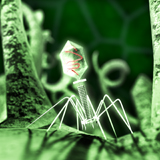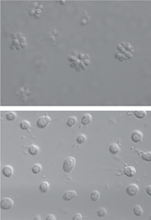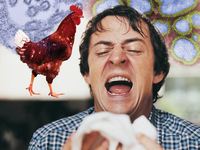
The cold sea fogs of Scotland have inspired many artists, but as a boy Jonathan Heras saw instead the North Sea oil fields and the prosperity they brought to his hometown of Aberdeen. So he became an engineer, earning a Ph.D. in chemical engineering from the University of Cambridge in the United Kingdom. But today, he makes his living as a graphic artist, and although his art is not inspired by Scotland’s scenery, his renderings of science are no less vivid than its raw and boisterous coast.
“Getting things to look authentic is the real trick. You need to add dirt and imperfections”. — Jonathan Heras
From the science behind the Large Hadron Collider experiment at CERN, the European particle physics lab; to the construction of the Bloodhound SSC, a car capable of speeds above 1000 miles per hour; to a portrait of a microscopic bacteriophage that recently received an honorable mention in Science magazine’s Visualization Challenge, Heras’s illustrations and animations depict a wide range of scientific concepts.
Heras, now 30, first explored animation in his early 20s when he and a university friend, Ivan Vallejo, directed a satirical stop-motion movie called The Polos of Death. Recorded on location in a college dorm room, the film features the action figure Boba Fett, from Star Wars, battling to the death a tribe of bloodthirsty Polos — a peppermint sweet — set to a soundtrack of Burt Bacharach and the Bee Gees. The film was “just a bit of fun,” Heras says, but he enjoyed the process of animation because it required him to be meticulous — a skill he seems to possess naturally and one he came to rely on during his Ph.D.
During his graduate studies in Cambridge’s Department of Chemical Engineering and Biotechnology, Heras looked at the flow patterns of liquid and gas through a catalytic converter using magnetic resonance imaging. His research subject proved difficult to convey to an audience at conferences, so Heras made short animated films of his flow-pattern data. “People don’t always remember what you are doing in terms of your research, but they do seem to remember you as the guy with the flashy animation,” he says, laughing.
Heras found his graduate work “quite frustrating,” he says. “The graphics were much more rewarding.” And so in his spare time he took on side projects that relied on his creative hobby. In one project, he was commissioned to make a safety video for his department. “We were surprised at how sophisticated a film he turned out,” says Mick Mantle, a chemist at Cambridge. “It became compulsory viewing for all new engineering students.” Heras “was a very, very bright student,” Mantle says, “but he preferred the image analyses side of things.”
In spring 2006, a few months from the end of his Ph.D., Heras set up as a freelance illustrator under the name Equinox Graphics, specializing in scientific visualizations. “Working from home was quite a struggle; you find that you work all sorts of crazy hours. I often watched TV at 5 in the morning because that was when I was up and working.”
Within 3 years he had enough work to need help, so he enlisted the animation skills of his friend James Waldmeyer, whom he knew from his undergraduate days. In 2009, he and Waldmeyer moved out of Heras’s spare room and into new premises on the outskirts of Cambridge. Heras still likes his home comforts, though, and sometimes works in his slippers.
Heras’s work relies on large amounts of computer processing power. He splits his workload across a network of 10 computers; even so, a frame of animation can take an hour to process. “If you have 25 frames per second and a minute of animation, it quickly adds up,” he says. The cost of all that computing power adds up too, and that affects his bottom line. “I know I could definitely earn more as a chemical engineer, but I wouldn’t have the job satisfaction I have,” he says.
Heras believes that keeping his work varied is key to staying successful. “It would be easy to just churn out many of the same images, tweaked to suit a particular client, … but this would be boring.” Instead, Heras picks projects he knows little about. He has animated a BMX trick that explains the basic physics of flying through the air on a bike (for the 100th anniversary celebration of Einstein’s Annus Mirabilis papers in 2005); a short documentary for the European Space Agency’s mission to orbit the sun with a satellite; a clip of an operation in which a device was inserted into a human vein to prevent a serious blood clot; and many more.
Heras’s first step toward creating an image is to learn as much as possible about the subject. “We start by researching on Wikipedia, and then we go to more detailed and accurate sources to fine-tune our understanding,” he explains. “We try to make [the] gulf of knowledge between us and the scientists as small as possible.” Heras and his partner come up with ideas and then meet with the client. Once they agree on the scope of the work, the real work begins. “Some of the images take a week to create,” he says.
Heras says he relies on what he already knows about science. However, the work requires some artistic license. All illustrators have to make these sorts of calls, he explains: “filling in the colors, the textures, the speeds that things move.” Heras cites the award-winning animation called The Inner Life of the Cell, made by Harvard University to take its biology students on a journey through a cell’s microscopic world. “It’s an amazing visual,” Heras says, but the space inside a real cell “is jam-packed with all sorts of things that are buzzing around. … It is not this vacuous space where you can see everything clearly,” as it is in the video. The video’s illustrators chose to simplify the cell so that viewers could more easily see what’s going on. Sometimes, he says, such editorial decisions are necessary, but they can be hard to make.
On the other hand, scientific illustrators must always be careful to make sure things don’t look too clean and pure, Heras says. “Getting things to look authentic is the real trick,” he says. “You need to add dirt and imperfections.” Knowing how to do that takes time, especially if you are self-taught. Heras says he picked up tips like these — indeed, most of what he knows about the craft — by reading blogs and online forums.
After so many years of formal education, earning a living from skills learned online and picked up in a college dorm room might seem strange. He says he still hasn’t completely convinced his parents that his career choice is a good one. But he hopes that in time they’ll come around, since he’s making a living and creating interesting things. Just as in his illustrations, seeing is believing.
:: Read original here ::
 MONTREAL, CANADA—When taking a dip this summer you will probably swallow tens, possibly hundreds, of microscopic plankton called choanoflagellates. These common organisms have led to an uncommon insight into how multicellular organisms might have evolved. Bacteria can prompt single-celled choanoflagellates to divide into multicellular versions of themselves, University of California (UC), Berkeley, biologist Nicole King reported last week here at the 71st annual meeting of the Society for Developmental Biology. King hopes the work will prompt biologists to look more closely at the role of microorganisms in the evolution of multicellularity.
MONTREAL, CANADA—When taking a dip this summer you will probably swallow tens, possibly hundreds, of microscopic plankton called choanoflagellates. These common organisms have led to an uncommon insight into how multicellular organisms might have evolved. Bacteria can prompt single-celled choanoflagellates to divide into multicellular versions of themselves, University of California (UC), Berkeley, biologist Nicole King reported last week here at the 71st annual meeting of the Society for Developmental Biology. King hopes the work will prompt biologists to look more closely at the role of microorganisms in the evolution of multicellularity.




